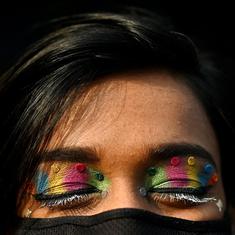Galwan Valley clash: Colonel Santosh Babu awarded Maha Vir Chakra, family says they are disappointed
Subedar Sanjiv Kumar has been posthumously awarded with the Kirti Chakra and four other soldiers have been awarded the Vir Chakra.

Colonel Santosh Babu, who was among the 20 soldiers killed in the line of duty when they clashed with Chinese troops in eastern Ladakh’s Galwan Valley on June 15, has been awarded the Maha Vir Chakra for his “conspicuous bravery in face of enemy, exemplary leadership and astute professionalism”, reported NDTV. The Maha Vir Chakra is the second highest wartime gallantry honour.
His citation said that Babu, deployed in Galwan Valley, was tasked with establishing an observation post, which he executed successfully.
“Undaunted by the violent and aggressive action by overwhelming strength of enemy soldiers, the officer in true spirit of service before self, continued to resist the enemy’s attempt to pushback Indian troops,” his citation said. “Despite being grievously injured, he led from the front with absolute command and control despite hostile conditions to deter the vicious enemy attack at his position.”
The citation also noted that the officer resisted the enemy attack till his last breath, inspiring troops to hold ground.
However, Colonel Babu’s family said they were very disappointed with the honour. “We are thoroughly disappointed,” Santosh Babu’s father Bikumalla Upender, a retired employee of State Bank of India, told Hindustan Times. “I was expecting my son would be conferred the Param Vir Chakra, the highest military award of the country, for the kind of sacrifice he made for the nation.”
He added that Colonel Babu’s sacrifice was not an ordinary one. “My son displayed tremendous courage to encounter the Chinese forces, which were in larger numbers. It was because of his bravery that Chinese forces had to beat a retreat,” he added.
Besides Babu, Subedar Sanjiv Kumar has been posthumously awarded with the Kirti Chakra, the peacetime equivalent of the Maha Vir Chakra. Four other soldiers – Naib Subedar Nuduram Soren, Havildar (Gunner) K Palani, Naik Deepak Singh and Sepoy Gurtej Singh – have been awarded Vir Chakra, the third highest wartime gallantry award, according to PTI.
A communication about Soren, a part of the 16 Bihar Regiment, said that he led his column and resisted the enemy’s attempt to push back the Indian soldiers while establishing an observation post. “He organised his column, countered the adversary forcefully and stopped them in their attempt to push back Indian troops,” it said. “During the skirmish, he was viewed as a daunting leader and was targeted by the enemy soldiers with lethal and sharp weapons.”
The press release said that Havildar Palani tried to defend his comrades even when the enemy attacked him with sharp weapons. “His act of valour inspired other fellow soldiers to fight fiercely and resist enemy aggression. Inspite of his grievous injuries, he continued to hold his ground resolutely and in the finest traditions of the Indian Army and laid down his life for the motherland,” it said.
Naik Deepak Singh, who worked as a nursing assistant, played an important role in treating and saving the lives of over 30 soldiers, it said. “In the ensuing skirmish coupled with heavy stone pelting, he received serious injuries, but undeterred and tirelessly, he continued to provide medical aid. The enemy outnumbered Indian troops and he was injured while carrying out his duty,” the communication said.
Sepoy Gurtej Singh, from the third battalion of the Punjab regiment, successfully spotted the enemy troops while establishing the observation post. “With utter disregard to his personal safety, he continued to fight the enemy valiantly and also extricated own injured troops, thereby saving a number of fellow soldiers of his patrol party before making the supreme sacrifice,” the release said.
Three soldiers have also been awarded the Shaurya Chakra, the peacetime equivalent of Vir Chakra. The Indian Army has already built a memorial for the “Gallants of Galwan” at Post 120 in eastern Ladakh.
India-China tensions
Following the clash at Galwan Valley, India and China have held several rounds of talks to resolve the border conflict but there has been no breakthrough so far. With nine rounds of Corps Commander-level talks failing to resolve the standoff, both countries have deployed troops and tanks in sub-zero conditions.
India and China on December 18 agreed to continue working towards ensuring complete disengagement of soldiers along the Line of Actual Control in eastern Ladakh as the border standoff between the two neighbouring countries continued.
On December 11, India had blamed China for the ongoing border standoff between the two countries, claiming that it tried to effect a “unilateral change” in the eastern Ladakh region. This came two days after Jaishankar said that the ties between the neighbours are passing through their most difficult phase, claiming that Beijing has offered “five differing explanations” for violating agreements on maintaining peace.









